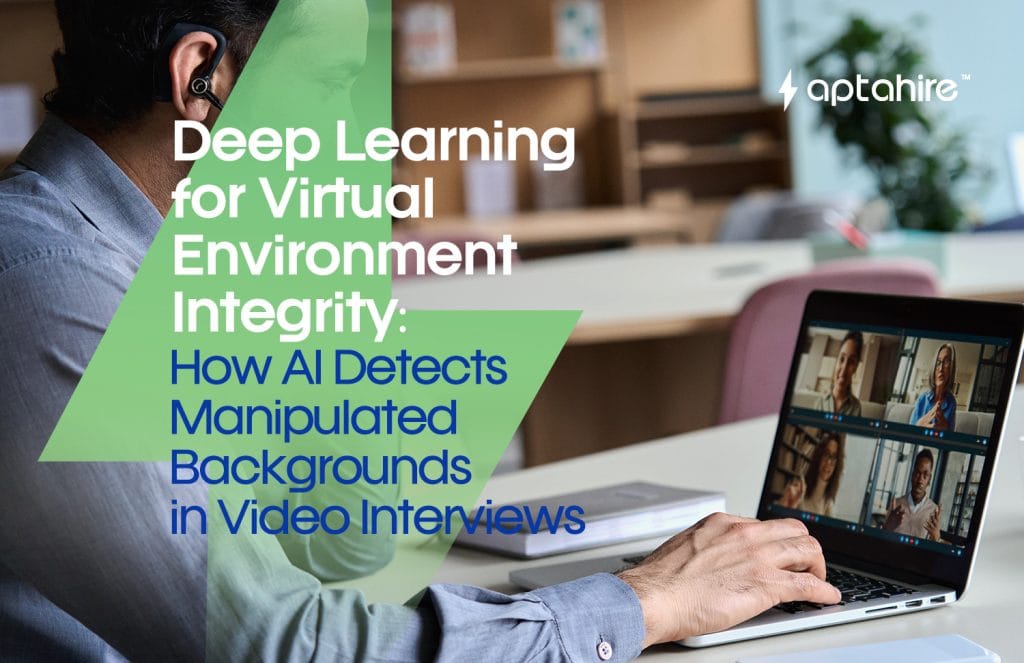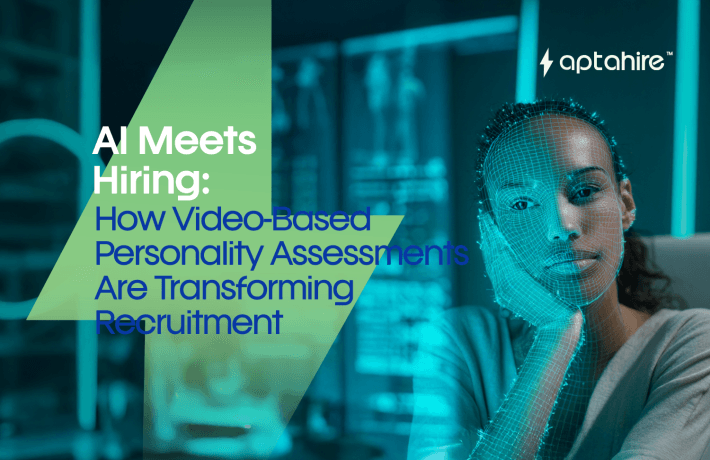Deep Learning for Virtual Environment Integrity: How AI Detects Manipulated Backgrounds in Video Interviews

Introduction
Imagine you’re conducting a virtual interview for a senior financial analyst role. The candidate appears in a sleek, professional home office, pristine bookshelves, a motivational quote framed on the wall, perfect lighting. Everything screams “I’m organized, detail-oriented, and ready for the role.”
But here’s the twist, that office? It doesn’t exist. It’s a stock image projected as a virtual background to hide a noisy café.
In today’s digital hiring space, such scenarios aren’t rare. With the rise of virtual backgrounds, AI-generated imagery, and even deepfake technology, candidates have more tools than ever to manipulate their interview environment. While sometimes backgrounds are changed for privacy or aesthetic reasons, there’s a thin line between harmless adjustments and intentional misrepresentation that could influence hiring decisions.
This is where Deep Learning for Virtual Environment Integrity comes into play. By using advanced algorithms, AI hiring tools can now detect manipulated backgrounds, identify inconsistencies in lighting and depth, and flag suspicious environmental changes in real-time. This isn’t just about catching dishonest candidates, it’s about ensuring fairness, authenticity, and trust in the hiring process.
In this blog, we’ll explore how deep learning algorithms work, why background integrity matters, real-world case studies, surprising statistics, and actionable tips for both recruiters and candidates.
Why Background Integrity Matters in Virtual Interviews
Background manipulation isn’t just about hiding a messy room — it can:
- Mask external assistance – e.g., someone feeding answers from behind the scenes.
- Create a false impression – making candidates appear more professional than reality.
- Bypass location restrictions – faking a presence in another city or country.
- Compromise data security – concealing prohibited recording equipment.
Stat Check: According to a 2024 HireVue survey, 17% of recruiters suspect that at least one candidate per hiring cycle uses virtual background manipulation to mislead interviewers.
How Deep Learning Detects Manipulated Backgrounds
Deep learning algorithms can detect tampering by analyzing multiple layers of visual data:
- Pixel-Level Analysis – Scanning for irregularities in lighting, shadows, and texture mismatches between the person and their environment.
- Motion Tracking – Identifying unnatural delays or “ghosting” when the subject moves but the background lags.
- Edge Detection – Spotting jagged outlines where a virtual background struggles to separate hair strands or clothing details.
- Light Source Consistency – Checking if the light on the candidate matches the lighting pattern in the background.
- Depth Perception Checks – Using AI vision to verify whether objects in the background are realistically positioned in 3D space.
- Pattern Recognition – Detecting repetition in background elements (e.g., a looping coffee steam animation).
Case Study 1 – The “Hotel Room” That Wasn’t
A financial services firm was interviewing a senior analyst. The candidate appeared to be in a quiet hotel room. However, the AI hiring platform flagged depth inconsistencies and shadow mismatches, suggesting a virtual overlay. Upon further questioning, it turned out the candidate was in a shared co-working space where a colleague was whispering suggested answers off-camera.
Outcome: The employer appreciated the transparency AI brought to the process and implemented mandatory background integrity checks in all future interviews.
Case Study 2 – The “International Location” Trick
A tech company was hiring a project manager in Singapore. A candidate claimed to be based locally and appeared in an office with a Singapore skyline. The AI background integrity model detected looped motion patterns in cars and clouds, revealing it was a static stock video background. The candidate was actually in another country.
Outcome: The company avoided relocation costs and potential visa issues.
Interesting Facts
- AI models like U-Net and YOLO can process 30 frames per second to analyze background authenticity without lag.
- Some advanced systems even detect audio-visual mismatches, e.g., reverb from a real environment that doesn’t match a visual background.
- In 2025, virtual background detection accuracy reached 94% in enterprise-grade hiring tools.
Tips for Recruiters to Ensure Virtual Environment Integrity
- Use AI-Powered Hiring Platforms – Choose systems with built-in background manipulation detection.
- Request a 360° View – At the start of the interview, ask candidates to briefly rotate their camera.
- Check Lighting Consistency – Look for shadows and natural lighting alignment.
- Ask Location-Based Questions – Subtly confirm the candidate’s stated location through contextual questions.
- Combine with Audio Analysis – Cross-check environmental sounds with the visible background.
The Future of Virtual Environment Integrity
We’re entering a hiring era where environmental authenticity will be as important as identity verification. With AI’s rapid advancements, future tools may not just detect fakes, they could instantly reconstruct the real environment behind the candidate’s mask, offering recruiters a transparent view without violating privacy.
Final Thoughts
The world of virtual hiring is evolving at lightning speed, and so are the methods candidates may use to influence perceptions. Deep Learning for Virtual Environment Integrity is not just a fancy tech buzzword, it’s a critical safeguard in ensuring interviews remain fair, transparent, and representative of the candidate’s real environment.
By leveraging AI’s ability to analyze texture mismatches, detect pixel-level inconsistencies, and cross-reference environmental cues, organizations can prevent fraudulent setups, protect against bias, and maintain the credibility of remote hiring.
But here’s the bigger picture: This isn’t about policing candidates into submission, it’s about creating a level playing field where skills, not illusions, determine opportunities. When candidates know the system values honesty, and employers trust the process, the hiring experience becomes smoother and more authentic for everyone.
As remote work becomes the new normal, we’ll see AI environment integrity checks become as standard as resume verification or reference calls. Companies that adopt such technologies early will be ahead of the curve, building teams rooted in trust and authenticity.
And in the end, it all comes down to one truth: The best background for an interview is integrity itself.
FAQs
1. What does “Virtual Environment Integrity” mean in AI hiring?
It refers to ensuring that the background and surroundings in a virtual interview are genuine and unaltered. This prevents candidates from faking locations, hiding distractions, or using virtual settings to mislead interviewers.
2. How does AI detect manipulated backgrounds during an online interview?
AI uses deep learning models to analyze visual cues like lighting consistency, object edges, texture quality, and pixel-level artifacts. These models can identify signs of green screen usage, virtual backgrounds, or digitally altered scenes in real time.
3. Why is background integrity important in virtual interviews?
The environment often provides indirect cues about professionalism, preparedness, and authenticity. A manipulated background might hide unethical behavior, allow external assistance, or create a false impression about the candidate’s work setup.
4. Can AI differentiate between a real background and a Zoom/Teams virtual background?
Yes. AI algorithms analyze discrepancies in depth perception, blur patterns, and movement consistency between the subject and the background to flag virtual or artificially inserted scenes.
5. Does detecting manipulated backgrounds invade a candidate’s privacy?
No. AI background analysis focuses on identifying inconsistencies rather than recording or storing sensitive data. Many solutions are designed to comply with GDPR, CCPA, and other privacy regulations.
6. What happens if a manipulated background is detected?
Depending on company policy, the interview may be paused, the candidate may be asked to switch to a real background, or the incident may be logged for further review before making hiring decisions.
7. Are there false positives in AI background detection?
Rarely, but they can occur. For example, low lighting, poor camera quality, or certain video compression effects may mimic signs of manipulation. That’s why AI systems often combine multiple detection layers to improve accuracy.
8. How accurate are deep learning models in spotting background manipulations?
Many advanced AI tools report accuracy rates above 90–95% in distinguishing real vs. altered backgrounds, especially when combined with motion tracking and lighting analysis.
9. Is background integrity checking common in all industries?
It’s becoming popular in industries where trust and compliance are crucial, such as finance, healthcare, legal, and remote-first companies, but adoption is growing across multiple sectors.
10. How can candidates avoid being flagged incorrectly?
They can ensure good lighting, use a clean and real background, check their camera quality before the interview, and avoid virtual background filters unless explicitly permitted by the recruiter.



